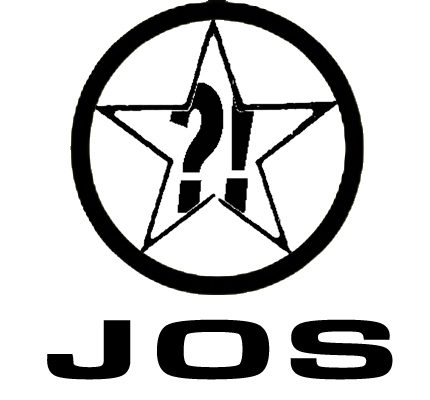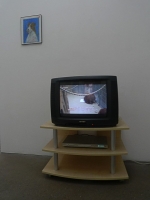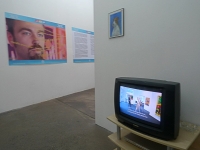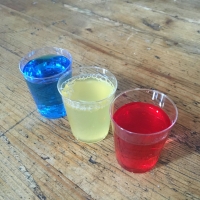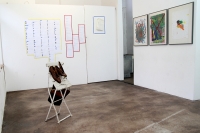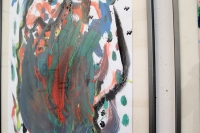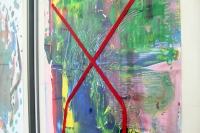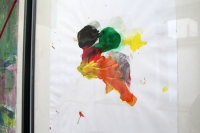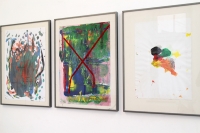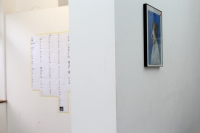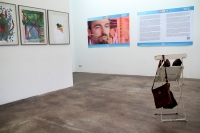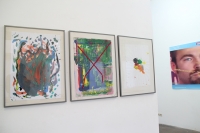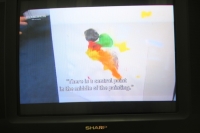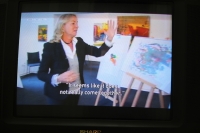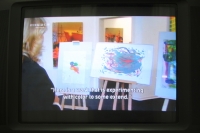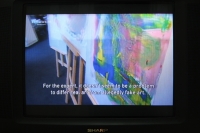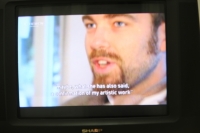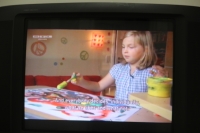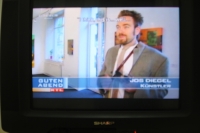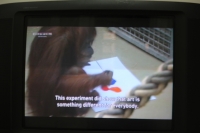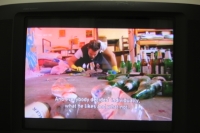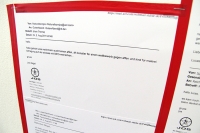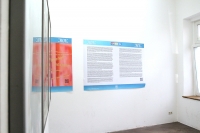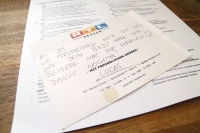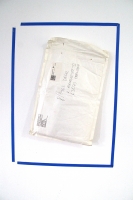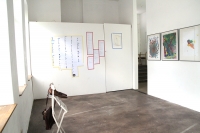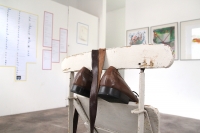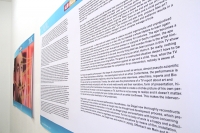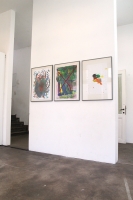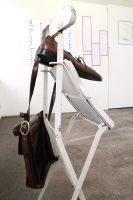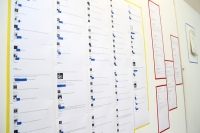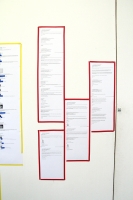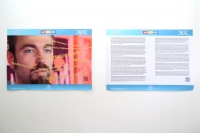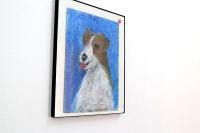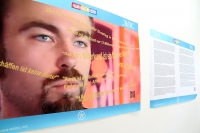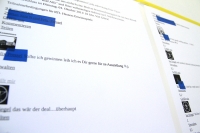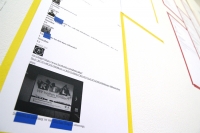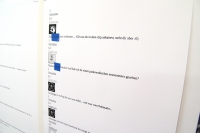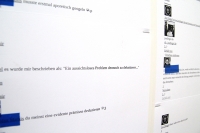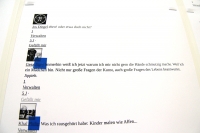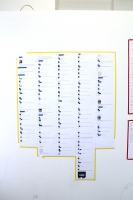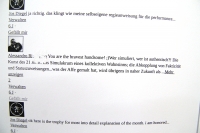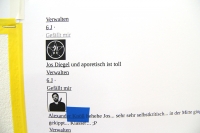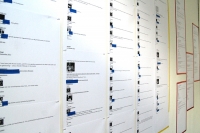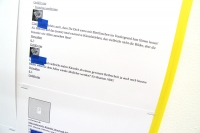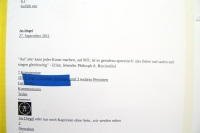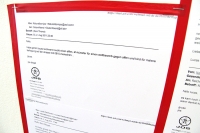YOU CAN´T SEE ME - SEE ME IF YOU CAN
2018
Solo Exhibition, Installation, Malerei und Konzept
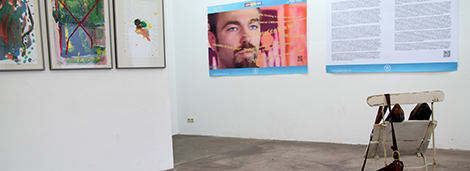
Ausstellungsprojekt in Zusammenarbeit mit Helmut, Leipzig, basierend auf einer performativen Intervention im TV Programm eines populären Fernsehsenders 2012
mit Dank an Natalie Vu, Maeshelle West-Davies, Christian Janneke, Eva Moll, Katrina Daschner, Clarissa Seidel uvm.
"Das ist ja auch ein ganz toller Einstieg in die abstrakte Kunst"
„Interessant, wie das mit der Kunst vor 13 Millionen Jahren mal angefangen hat.'"
"Kunst ist das nicht"
"Kunst ist ein Reflexionsmedium. Kinder und auch Affen malen wild drauflos. Das Wort 'Kinderkunst' ist ein falscher Begriff"
"Affen und Kinder sind per se keine Künstler"
Ein besonderes anregendes Lehrstück für die post-moderne Wahrnehmung in der regionalen Fernsehlandschaft liefert der deutsch-niederländische Künstler Jos Diegel (geb. 1982). Genau genommen handelt es sich künstlerisch um eine besondere Form konzeptioneller Überhöhung und Zweckentfremdung. Am 26. September 2011 will es ein deutscher Fernsehsender in einem Kurzbericht einer regionalen Sendung wissen: Können Affen und Kinder moderne Kunst machen oder ist ein professioneller, authentischer Künstler den beiden deutlich überlegen? Die Antwort soll ein Malwettbewerb geben. Dabei gelten für alle die gleichen Bedingungen: ein Papier von 70cm*50cm, vier Fingermalfarben in Rot, Grün, Gelb und Blau, zwei Pinsel in verschiedenen Größen und zehn Minuten Zeit.
Und los gehts. Drei vermeintlich kreative und doch so austauschbare Kategorien treten gegeneinander an. Das ist die Erzählung, dabei werden Rollenbilder wie das des Kindes, des Affen und zu allererst einmal das des Künstlers sowie die Wahrnehmung von Kunst feierlich reproduziert und bestätigt. Nachher werden die drei Bilder Passanten in einem Frankfurter Shopping Center gezeigt und diese müssen erraten, wer das Bild gemalt hat, Künstler, Kind oder Affe. Das ist ein sehr unterhaltsames Quiz, hat dabei aber vermeintlich auch einen tieferen Sinn. Denn damit werden zentrale, sowohl kindische als auch kindliche, anthropomorphe Fragen gestellt: was überhaupt ist Kunst und kann Kunst einfach definiert werden? Welches Kompositionskonzept verfolgt der oder die Künstlerin? Verfolgen Affen und Kinder eine ästhetische Intention? Welche Rolle spielt der Betrachter? Beginnt der künstlerische Prozess vielleicht erst, wenn es spielerisch für Affe und Kind uninteressant geworden ist? Wurden im Fall malender Affen und Kindern nur Quasi-Kunst erzeugt? Aus der Perspektive der Kunstwissenschaft bringt erst eine komplexe Dreiecksbeziehung zwischen Künstler, Objekt und Betrachter ein „Kunstwerk“ hervor. Abgesehen davon aber haben wir es hier mit einer weitaus komplexeren Dreiecksbeziehung zu tun.
Das kann ja jedes Kind, wird oft gesagt und tatsächlich gibt es so eine Sehnsucht, so unbefangen und unbelehrt malen zu können wie ein Kind. So manche/r Künstler oder Künstlerin konnte schon früh malen, aber benötigte ein Leben lang, wieder malen zu lernen wie ein Kind. Malende Affen sind seit Jahrhunderten ein Motiv in der Kunstgeschichte. Der Affe wird zum Wappentier und Symbolfigur im Auftrag der Kunst. Als genialer Dilettant und Nachäffer der Schöpfung wird der Affe zum Markenzeichen künstlerischen Selbstverständnisses. Und als drittes der Künstler, der Künstler selbst ist an alledem nicht interessiert. Eigentlich wurde in dem Fernsehbeitrag mit einem sehr schlechten Werk bewiesen, dass eine Galeristin die Arbeit eines Künstlers erkennen kann, sonst nichts. Nichts wurde bewiesen, was nicht schon längst zur Beweisführung gebracht wurde. Teil einer konstruierten Situation muss es nicht sein, sich als Künstler oder Künstlerin zu beweisen und den Malwettbewerb zu entscheiden. Was die TV-Redaktion nicht weiß, dieser Künstler ist mit von der Partie um einer Intervention Willen, von der niemand wußte.
Für diese ortsspezifischen Performance in Gestalt von einem humorvollen, aber auch ernsten, fast pseudowissenschaftlichen Kurzbeitrags, eignete sich Diegel ein Alter Ego an - die stereotype Rolle eines Künstlers. Inhaltlich basierte die Performance auf vorhandenen dokumentarischen Fragmenten, die er in Künstler/innen-Interviews, Künstler/innenfilmen, -berichten und Bio-Pics oder eigenen Aussagen vorfand. Dabei bedient sich der Ku?nstler des Phänomens Fernsehbeitrag über Kunst und setzt sich selbstkritisch und spielerisch mit Kunst- und Medienbetrieb und deren Narrative, Präsentationsformen, Hierarchien sowie Ausschlussmechanismen auseinander.
Er hatte sich entschieden ein Klischeebild seines persönlichen künstlerischen Selbst zu kreieren. Er ist gar nicht so, wie er im Fernsehen erscheint, aber das ist gar nicht so einfach zu erkennen und egal. Wenn man ihn nicht kennt, sieht man sich möglicherweise in seinem Klischeebild eines Künstlers bestätigt. Das macht die Intervention ebenso problematisch wie die mediale Aufarbeitung von Kunst.
Für viel Aufsehen sorgte Diegel mit einer geheimen Performance nicht. Für die Ausstellung rekonstruiert Jos Diegel aber nun als Premiere umfassend das Geschehenen und gewährt Einblick in den Gedanken- und Entwicklungsprozess, die der Intervention voraus- und anbeigingen.
In seiner Kunst spielt und unterhält Jos Diegel mit Themen u?ber sozialpolitische Fragen und normative Erzählstrukturen. Fu?r ihn ist sein Gesamtkunstwerk eine glu?ckliche und adisziplinäre experimentelle Wissenschaft, in der er mit den Mitteln von Film, Installation, Malerei, Aktionskunst und Literatur Situationen verhandelt und konstruiert. Jos Diegel lebt und arbeitet in Leipzig, Offenbach am Main und Berlin.
___________
An especially inspiring and instructive play for the post-modern reception within the regional TV landscape is offered by German-Dutch artist Jos Diegel (born 1982). Strictly speaking, it‘s about a special form of artistic superelevation and misappropriation. On September 26th, 2011, a German TV Channel wants to find out in a short report: Can apes and children make modern art or is a professional authentic artist clearly superior to both? The answer shall be given in a painting competition under the following conditions: a paper of 70cm*50cm, four finger paint tubes in red, yellow, green and blue, two brushes in different sizes an a ten minutes time limit.
Here we go! Three allegedly creative and at the same time interchangeable categories face each other. That‘s the narrative, thereby role clichees and images of an ape, child and foremost of the artist are to be solemnly reproduced, as well as the common reception of art itself. Later on, the three paintings will be presented to passer-bies at a shopping center in Frankfurt who are asked to guess which painting was made by the ape, child and artist. That is definitely an entertaining quiz, but it might have a deeper sense as well. The central curious as well as childish, anthropomorphic question might be: What is art in the end and can art easily be defined as such? Which compository concept is pursued by the artist? Does an ape and a child pursue an aesthetical intention? Which role does the audience play? Can children and apes only produce fake art?
From a science-of-art-point of view only a complex ménage à trois of artist, object and audience results in a true artwork. Nonetheless, here, we are treating a certainly even more complex ménage à trois.
‚Any child could do that‘, is often said and indeed, there is a desire to paint ingenuously and unprejudiced like a child. Some artists were able to paint early on in their life, but needed a whole lifetime to learn again how to paint like a child. Painting apes have been in the focus of art history for centuries. The ape becomes a heraldic and symbolic animal by the order of art. As a genius amateur or copycat in God's creation, the ape becomes a mascot of artistic self-understanding and self-consciousness. And number three is the artist himself, everything said, he is not interested at all. In the end, the only thing that has been proven in this TV show with a very bad art work, that an art dealer can recognize the art work by an artist, that‘s it. So really, nothing has been proven, that had not been proven long before. The goal of a constructed situation doesn‘t have to be to prove oneself as an artist by winning a painting competition against an ape and a child. Thus, what the TV production company did not know: this artist takes the competition for an intervention, nobody is aware of.
For these site specific performances in the shape of a humorous as well as serious, almost pseudo-scientific report, Diegel appropriates an Alter Ego – the stereotypical role of an artist. Contentwise, the performance is based on available documentary fragments, which he found in artist interviews, artist films, reports and Bio Pics as well as his own testimonials. Thereby, the artist uses the phenomena of a TV report about art and grapples self-critically and playfully with the art and media world and their narrative, form of presentation, hierarchies as well as their mechanisms of exclusion. He had decided to create a clichée picture of his own personal artistic self. He really is not like he appears on TV, but this is not so easy to realize and it doesn’t matter. If you don’t know him, you probably feel your clichée picture of an artist confirmed. This makes the intervention as well as the medial rehabilitation of art problematic.
Diegel didn‘t cause a stir with his secret performance. Nonetheless, Jos Diegel now thoroughly reconstructs the happening for this exhibition and allows an insight into the thought and development process, which precursed and accompanied the intervention. In his art Jos Diegel plays and entertains with topics concerning social-political questions and normative-narrative structures. To him his body of work is a happy and a-disciplinary experimental science, where he negotiates and constructs situations by means of film, installation, painting, performance and literature. Jos Diegel lives and works in Leipzig, Offenbach am Main and Berlin.
